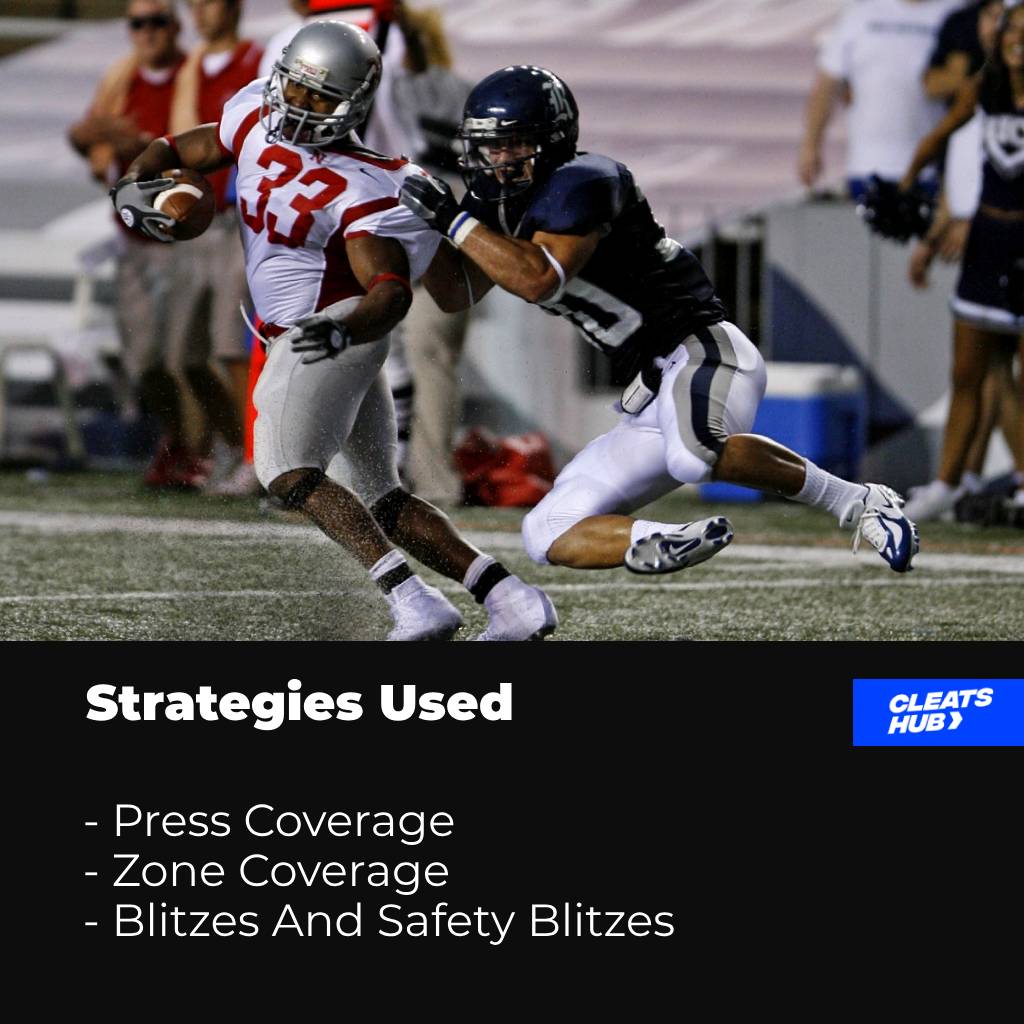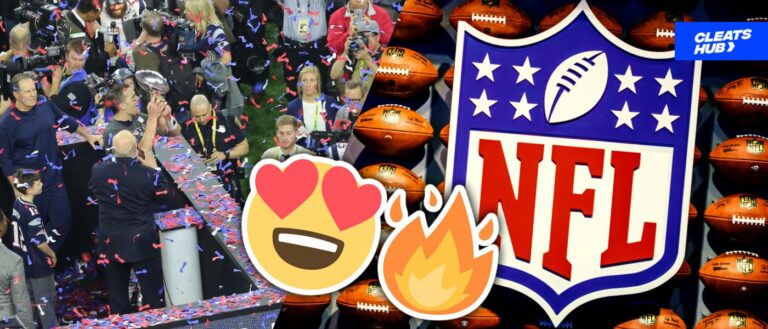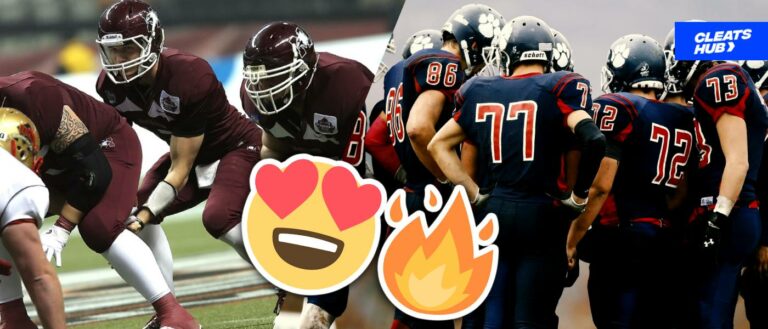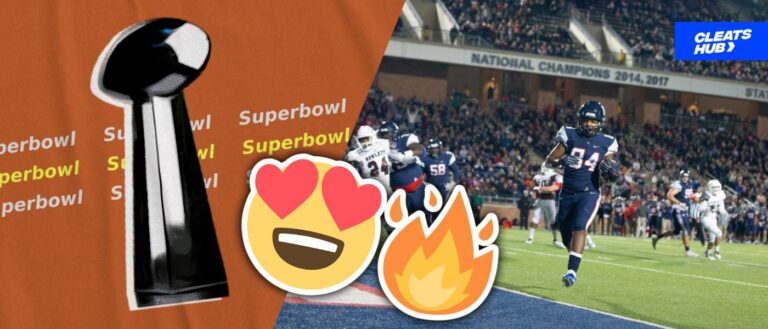What Is The Secondary In American Football?
American football is a tactically difficult sport in which players must execute certain roles inside their allotted positions. The secondary is an important aspect of any football defense.
We shall look at its role, vital positions, duties, and tactics for containing the opposing team’s passing attack here at Cleats Hub.
What is the Secondary?
The secondary is a critical component of modern football pass defense. Their primary purpose is to prevent the opposing team from completing passes, causing turnovers, or minimizing the damage done by successful completions.
Nevertheless, the secondary can have a significant impact on the outcome of a game by efficiently covering receivers and interfering with the quarterback‘s timing.
Role of the Secondary

1. Coverage
The primary responsibility of the secondary is to provide coverage against the opposing team’s receivers. They may achieve this mostly through zone coverage and man-to-man coverage.
In man-to-man coverage, each defensive back is responsible for covering a specific receiver and attempting to stick with them throughout the play. Defensive backs use zone coverage to divide the field into zones, assigning each player to cover a certain section.
Using this strategy, defenders may also read the play, keep their eyes on the quarterback, and respond correctly. Defensive players must also be adept at seeing and anticipating the various routes that receivers take in order to adjust their coverage.
2. Run Support
While the secondary is primarily focused on pass defense, players of this unit also aid in run defense. Safeties must be able to diagnose an offensive play, detect runs, and provide support close to the line of scrimmage.
Furthermore, cornerbacks often focus on pass coverage, but they may be required to provide run support on occasion.
3. Ball Skills and Turnovers
The secondary plays an important part in producing turnovers by frequently intercepting passes or inducing fumbles. Defensive backs must have exceptional ball skills, including timing, hand-eye coordination, and the ability to predict the path of the ball.
Nevertheless, by making important plays such as interceptions or forced turnovers, the secondary can alter the course of a game and provide their team’s offense with critical field position.
Key Positions in the Secondary

- Cornerback:
Cornerbacks, sometimes known as “CBs”, are often the quickest and most nimble defensive players. Their major responsibility is to cover wide receivers and prevent them from receiving passes. Cornerbacks must be agile, anticipate well, and be able to change directions quickly.
- Safety:
Safeties are versatile players who must stop both the pass and the run. Strong Safety (SS) plays closer to the line of scrimmage, supporting runs and covering tight ends. The free safety (FS), who is positioned further back, provides deep coverage and supports the defense against long passes.
Rules a Secondary Has To Follow

The secondary is bound by particular regulations that specify how they must behave on the pitch. Some of the primary guidelines that the secondary must follow are listed below:
1. Pass Interference
Pass interference occurs when a defensive player makes it more difficult for a qualifying receiver to receive a pass.
Contact or movement restriction may be involved. The secondary must avoid pass interference crimes such as gripping or shoving the receiver before the ball is released.
If pass interference is found, a penalty is issued, which usually results in the offender getting a first down.
2. Illegal Contact
Defensive players are not permitted to make contact with offensive players beyond five yards beyond the line of scrimmage. After the ball is in the air, illegal contact is no longer enforced, and pass interference rules apply instead.
3. Defensive Holding
Defensive holding occurs when a defensive player restricts an offensive player’s movement before the ball is thrown. This infraction results in a five-yard penalty and an automatic first down for the offense.
4. Defensive Pass Interference in the End Zone
If a defensive pass interference foul occurs in the end zone during a scoring pass, the offense receives the ball at the one-yard line or a touchdown.
5. Defensive Holding on Running Plays
During running plays, defensive players are not permitted to hold offensive players. The penalty for holding on to a rushing play is normally five yards from the violation.
6. Out-of-Bounds Coverage
The backup player must be aware of the sideline lines. If a pass is intercepted or touched while any part of the defender is outside the field, it is deemed incomplete.
Strategies Used by the Secondary

1. Press Coverage
Press coverage defensive backs play aggressively at the line of scrimmage to obstruct receiver routes. The purpose of this approach is to throw off the timing of the quarterback and receiver, resulting in hasty decisions and possibly blunders.
Defensive players can also disrupt receivers’ timing on their routes and prevent planned passing plays by pressuring them at the line.
2. Zone Coverage
Zone coverage involves defenders splitting the field into zones and securing specific parts rather than focusing on a single receiver.
Secondly, by employing this method, defenders can keep their eye on the quarterback, read the play, and respond correctly. They want to prevent the offense from finding free passing lanes by effectively securing their allocated zones.
3. Double Coverage
When a receiver is very dangerous, he is covered by two defenders. The defense may decrease a standout receiver’s impact on the game by putting more effort into stopping them.
It is worth mentioning that top receivers who pose significant threats to defenses are typically targeted with double coverage.
4. Blitzes and Safety Blitzes
Blitzes could be used by defensive coordinators to rush the quarterback and force hurried, erroneous throws. More pass rushers are sent by the defense to disrupt the timing and flow of the opposing team’s throwing attack.
Furthermore, the use of safety in blitz packages may provide a surprise factor and make it more difficult for the quarterback to read the defense.
Notable Secondaries in NFL History

There have been many great secondary units in NFL history. However, we have mentioned some below:
1. The Seattle Seahawks’ Legion of Boom (2010s)
The Legion of Boom of the Seattle Seahawks was one of the most effective secondaries in recent memory. Richard Sherman led the Legion of Boom, which also comprised Byron Maxwell, Kam Chancellor, and Earl Thomas.
This secondary was well-known for its strength, great coverage, and ball-hawking talents. They were also critical to the Seahawks’ Super Bowl victory in 2014.
2. Baltimore Ravens’ Defensive Backfield in the 2000s
The Baltimore Ravens’ defensive backfield was a formidable one in the early 2000s. This secondary, which featured notable players such as Ed Reed, Ray Lewis, Chris McAlister, and Rod Woodson, was known for its superior coverage and playmaking abilities.
Furthermore, Hall of Fame safety Ed Reed stood out for his instinctive play and ability to force turnovers.
3. The Oakland Raiders’ Soul Patrol in the 1970s
Soul Patrol was a potent secondary squad in the 1970s. Willie Brown, George Atkinson, Jack Tatum, and Skip Thomas were all in this secondary.
It was also known for its rugged play and authoritative presence on the field. They were critical to the Raiders’ success during that time period, which included a Super Bowl XI victory.
4. Denver Broncos “No Fly Zone” secondary (2010s)
The Denver Broncos’ “No Fly Zone” secondary was a potent unit in the 2010s that helped the team win the Super Bowl in 2015. This secondary featured standouts like Aqib Talib, Chris Harris Jr., T.J. Ward, and Bradley Roby.
Furthermore, they developed a suffocating defense that made it difficult for opposing quarterbacks to succeed through the air due to their exceptional covering talents and aggressiveness.
5. Green Bay Packers Defensive Backfield (the 1960s)
The Green Bay Packers’ defensive backfield in the 1960s, known colloquially as the “Golden Boy” defense, was a crucial component of the team’s dominance at the time.
This secondary, captained by Hall of Famers Willie Wood and Herb Adderley and included safety Tom Brown, was known for its versatility, quickness, and covering abilities.
Furthermore, they had a significant impact on the Packers’ Super Bowl victories in I and II.
Conclusion
To say the least, the secondary in American football is critical to pass defense. Cornerbacks and safeties work together to provide coverage, run support, and force turnovers.
Second, they are in charge of more than simply the individual receivers since they must determine the quarterback’s objective.
Furthermore, the secondary aims to hinder the other team’s passing strategy and give their team a competitive advantage by employing various techniques such as press coverage, zone coverage, and double coverage.







